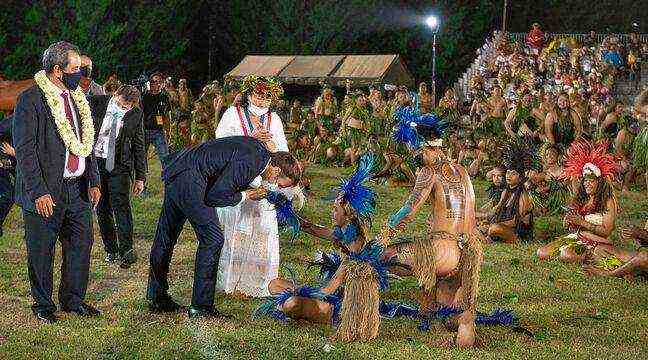Arrived in Tahiti on Saturday for a trip of a few days to French Polynesia, President Emmanuel Macron made a remarkable visit to the Marquesas. On Sunday, he went to Hiva Oa, one of the six inhabited islands of this archipelago located north of the Overseas Territory. Notably, this is the first time that a French president has visited the Marquesas Islands. “This is precisely why he had the idea, breathes Michel Bussi, writer and geographer. All presidents try to find something original for the first time. “
And on the original side, the president was served because the Marquesans have a well-marked and typical culture. “They have a very strong identity with their own language (Marquesan) or even very specific Marquesan dances compared to the rest of Polynesia”, details Caroline Blondy, lecturer in geography, whose thesis addresses questions around tourism in Polynesia. “The very spectacular side of the reception of the Marquesans with a ceremony which pays tribute to the chef and the leader, that makes very beautiful images for Emmanuel Macron”, underlines Michel Bussi.
Electoral side, on the other hand, no big expectations, nor big stakes: for the specialist in electoral geography, the displacement is not necessarily strategic for the elections of 2022, because the Marquesas have only 10,000 inhabitants. “It won’t really have any influence. “
A risk-free visit
Another advantage, the President was less likely to have a bad reception when going to the Marquesas Islands than in the Drôme for example. “When you’re a Marquesan, the fact that a head of state comes, that the media are interested in it, it’s a historic event that will not happen again for a very long time, so there is something extraordinary” , explains Michel Bussi, recalling that the stakes are not the same as in metropolitan France. “There are no” yellow vests “in the Marquesas, moreover there is only one roundabout! “
“In addition, the Marquesans are very attached to France because they feel peripheral to Tahiti. They prefer to depend on the State than on Tahiti because they have more to gain from it. It’s fairly standard in isolated areas, ”continues the expert.
An incredible spotlight for the territory
Indeed, French Polynesia is a territory as vast as Europe, divided into five subdivided archipelagos which bring together 118 islands. “The issue of accessibility and territorial discontinuity is a real issue, particularly in terms of tourism development,” reports Caroline Blondy. The only international entry is via the island of Tahiti. You then have to catch a plane to get to the Marquesas Islands, which are located in the far north of Polynesian territory, almost 5-6 hours away. “The ticket is almost as expensive as going to Los Angeles”, continues the geographer. In addition, not all islands have an airport and some are only accessible by sea.
In addition to its lack of accessibility, the Marquesas are relatively unknown to the general public. “It is a forgotten territory, which the French know as distant islands, sometimes without knowing that it belongs to France”, assures Michel Bussi. The arrival of the President is therefore an incredible spotlight for a territory “with tourist frequentation still very confidential, since it receives for the moment on average 5,000 international tourists per year”, analyzes Caroline Blondy.
A helping hand to become a UNESCO World Heritage Site
Visibility for tourists, but perhaps also a boost to become part of Unesco’s world heritage. The request formulated for a long time by the Marquesas Islands was also the subject of the president’s visit. And the territory does not only have a cultural heritage to highlight. “The archaeological heritage is quite fantastic, with the marae, Polynesian places of worship which date from the pre-colonial period very well preserved or very well restored, but also archaeological sites of villages built before the arrival of Europeans”, describes Caroline Blondy.
Finally, the natural heritage is very diverse in terms of landscape and biodiversity. “We have Ua Pou with its impressive pillars or Nuku Hiva and its fantastic bay,” comments the geographer. In Ua Huka, there are landscapes that look a bit like Easter Island, but also its semi-wild horses for an island that has only a few hundred inhabitants. “
Becoming a UNESCO World Heritage Site would allow the preservation and enhancement of this heritage and would also have advantages in terms of tourist attendance. A plus for the island sector which, like all overseas territories, suffered from the Covid-19 crisis.

